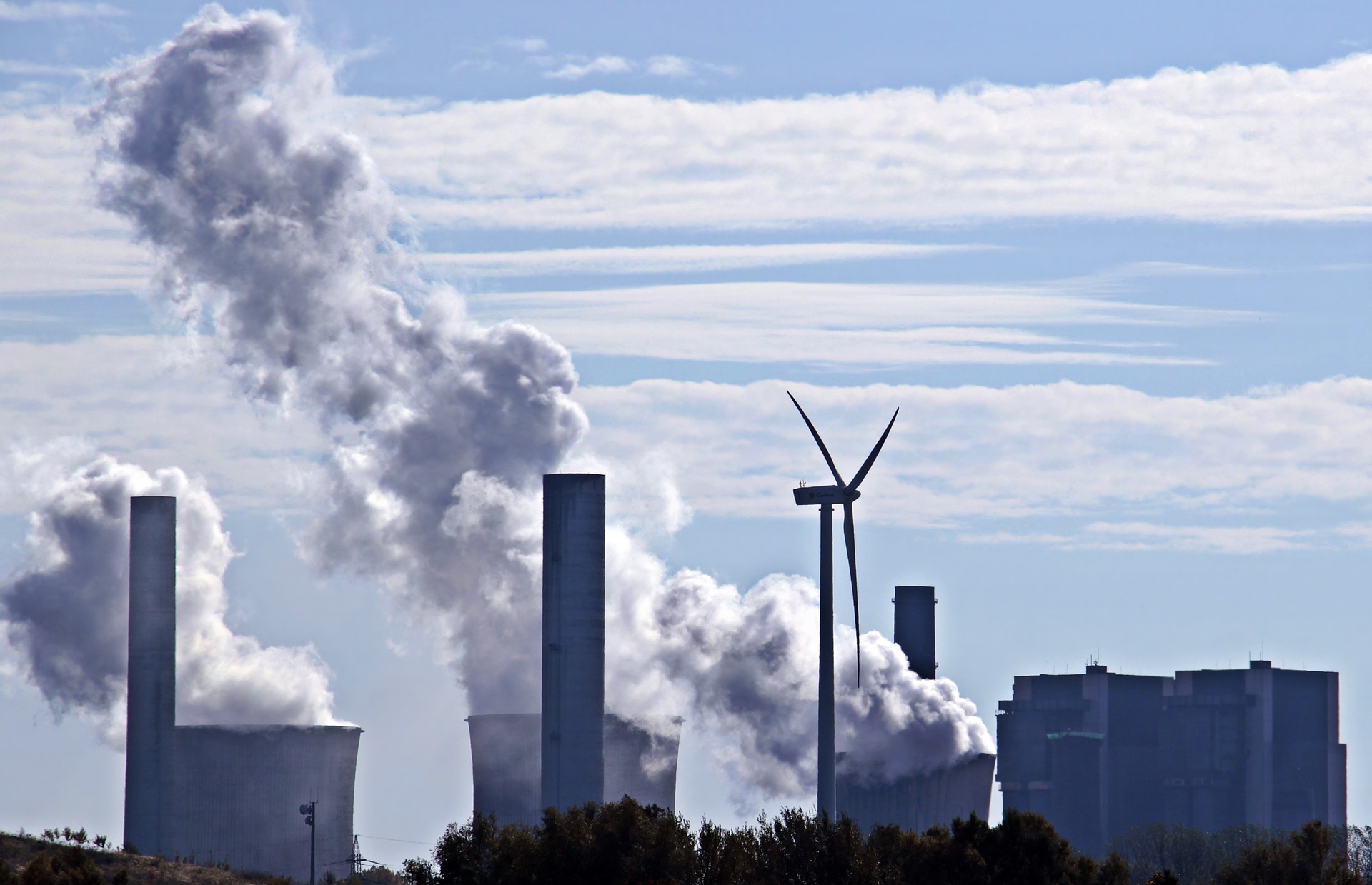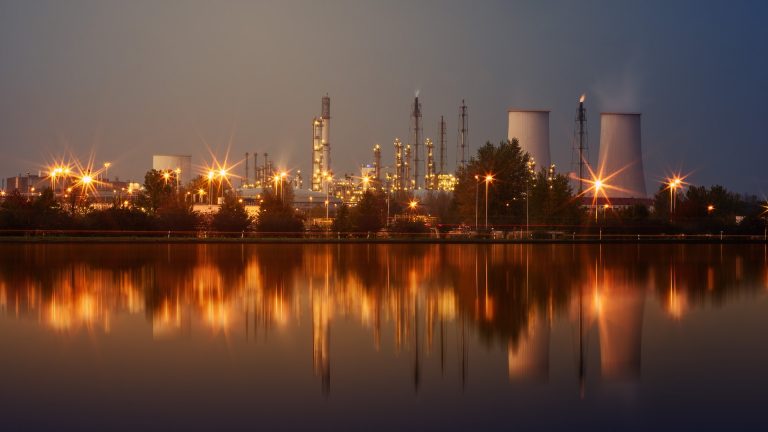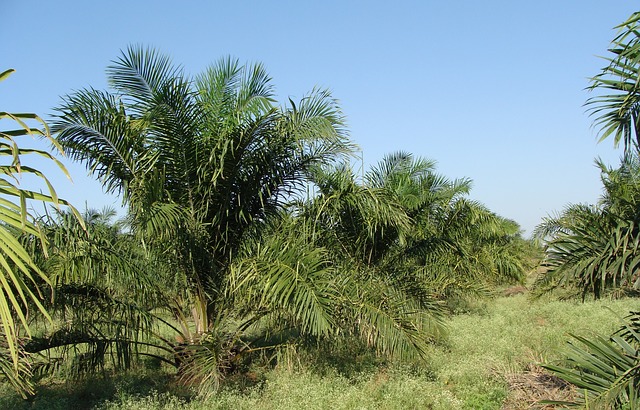Defining Investments in Indonesia’s Energy Sector
Irwansyah and Fariz Panghegar, Traction Energy Asia
The main purpose of this article is to establish a definition of the energy sector in Indonesia, as well as a categorization of what products, activities and services it includes, that will be used by Traction Energy Asia (Traction) in subsequent research and advocacy to achieve a comprehensive understanding of investments in Indonesia’s energy sector.
Indonesia has an abundance of potential energy resources, both from fossil and non-fossil sources. As the world’s fourth most populous nation, and one of the fastest growing economies amongst the group of emerging middle-income countries, Indonesia’s energy consumption has been increasing significantly, and is predicted to rise even more rapidly in future. As a result, Indonesia’s energy sector has become one of the most strategic sectors for investment. Given the significant potential economic, environmental, political, social and health impacts of investments in Indonesia’s energy sector, it is crucial to conduct comprehensive research analysis to assess both the negative and positive impacts, and to use this as a basis for recommending improvements.
This is challenging because Indonesia’s Investment Coordinating Board (Badan Koordinasi Penanaman Modal/BKPM) has no agreed definition of the ‘energy sector’, nor any comprehensive categorization of what the sector includes, to guide its system of data collection on investment realizations. A definition of the energy sector needs to be formulated first to inform a comprehensive categorization of energy sector investments. This article attempts to formulate such a definition through desk research and analysis of literature discussing various definitions of energy sector investments, and to match these definitions with existing databases on investments in the energy sector.
Existing ‘Energy Sector’ Definitions in Indonesia
In the majority of studies published by research and advocacy groups pertaining to issues of energy and environment, the energy sector has not been completely defined, both in its proper definition as well in the scope of its business activities. In a number of case studies on the social and environmental impacts of coal mining and power generation for example, the energy sector is used freely to refer to a specific group of business activities (AEER 2019[1]Sartika Nur Shalahati & Jasman Simanjuntak. 2019. China Investment in The Coal Power Plant Sector in Indonesia: Finance and Portrait of Social, Environmental and Labor Impact. Report. Jakarta: … Continue reading; Auriga 2019[2] Auriga. 2019. “Bank dan Investor Bakar Uang di Energi Kotor”. Report. Jakarta: Auriga. Obtained from … Continue reading, Walhi 2020[3] Walhi. “Tinjauan Lingkungan Hidup 2020: Menabur Investasi Mennabur Krisis Multidimensi”. Report. Jakarta: Walhi. Obtained from … Continue reading). Meanwhile, in Indonesia’s regulatory framework, the definition of energy and its scope is established in Law No. 30 of 2007 on Energy, as follows:
“Energy is the ability to do work that can be in the form of heat, light, mechanics, chemistry, and electromagnetism. An energy source is something that can produce energy, be it directly or through a process of conversion or transformation. An energy resource is a natural resource that can be used as a source of energy or as energy (Law No. 30/2007, Article 1, Paragraphs 1, 2, 3).”
Energy sources are classified into three groups, namely new energy sources, renewable energy, and non-renewable energy. This classification is regulated in Law No. 30/2007, Article 1, Paragraphs 4, 6, and 8.
There are at least three other regulations concerning energy, namely Law No. 22/2001 on Oil and Gas; Law No. 3 of 2020 on Mineral and Coal; and Law No. 30/2009 on Electricity. All of these regulations have differing definitions on the mapping of energy sector business activities, in the form of exploration and extraction of energy resources, transformation of energy resources into energy, and energy transmission and distribution.
Through a literature review, we have found definitions of the energy sector in Law No. 30/2007 on Energy, Law No. 22/2001 on Oil and Gas, Law No. 3/2020 on Mineral and Coal, and Law No. 30/2009 on Electricity and IEA (2002), which we have summarized as follows:
“The energy sector is the totality of energy provision business activities, consisting of the exploration and extraction of energy resources; the transformation of energy resources into energy; and energy transmission and distribution for both renewable and nonrenewable energy.”[4]We use the International Energy Agency (IEA) classification for renewable and non-renewable energy rather than Indonesia’s Energy Law No.30/2007 as this includes a vague classification of “new … Continue reading
We have also discovered a definition of energy sector activities in Law No. 30/2001 on Oil and Gas, Law No. 3/2020 on Mineral and Coal, Law No. 30/2009 on Electricity, and the Energy Balance Sheet of the Ministry of Energy and Mineral Resources (Kementerian Energi dan Sumber Daya Mineral/ESDM)[5]See Kementerian Energi dan Sumber Daya Mineral. 2018. “Handbook of Energy and Economic Statistics of Indonesia”. Report. Jakarta: Kementerian Energi dan Sumber Daya Mineral (ESDM). Page 16-17.. The description of energy sector activities used in all of the above is as follows: The first is the exploration of energy resources, which refers to business activities conducted in order to acquire information on the location, form, dimension, spread, and quantified quality of energy resources, as well as information on the surrounding social and environmental areas. The second is the extraction of energy resources or exploitation, which refers to business activities encompassing mining, processing, and/or smelting of raw energy resource materials within a mining location and its auxiliary businesses. The third is transformation, which refers to a process of transformation of energy resources (primary and alternative energy resources) into a final form of energy. In the balance sheet of the Ministry of Energy and Mineral Resources, transformation activities include: oil refining, natural gas processing, power plants, biofuel blending, and regasification of natural gas. The fourth is energy transmission, which refers to the distribution of energy from transformation businesses (energy processing) and power plants to an energy distribution system. The last is energy distribution, which refers to the distribution of energy from a transmission system to consumer users of energy.
With regard to the definition of investment, the Law No. 25/2007 on Investment, defines investment as follows:
“[A]ll forms of investment activity by both domestic and foreign investors, in order to conduct business within the state territory of the Republic of Indonesia.”
Nonetheless, within the various laws and regulations concerning energy, no definition can be found on energy sector investment. Therefore, we need to place the definition of energy within an investment context by comparing it with other sources.
Defining Energy Sector Investments in Indonesia
Universally, energy is defined as a material in various forms that must be transformed in order to conduct an activity (Smill 2017)[6]Vaclav Smill. 2017. Energy and Civilization: A History. London: The MIT Press. Page 1.. The definition of energy is dynamic and experiences changes in accordance with developments in technology and social life. Wiser (2000) also emphasizes that the dynamic nature of energy is due to it working in accordance with the First Law of Thermodynamics, in that energy cannot be created nor destroyed, but can transform into other forms.[7]Wendell H. Wiser. 2000. Energy Resources Occurrence, Production, Conversion, Use. New York: Springer. Page 9.
The United Nations Statistic Division (UNSD) formulated the International Recommendation for Energy Statistics (IRES), as a recommendation on methods of statistical data collection for the energy sector. IRES’ proposed energy flows are illustrated in the following diagram:[8]United Nations Statistics Division (UNSD). 2018. “International Recommendation for Energy Statistics (IRES)”. Statistical Papers. Series M No.93. New York: United Nations. Page 56-58.
Diagram of Energy Flows:
International Recommendation for Energy Statistics (IRES),
UN Statistic Division (2018)
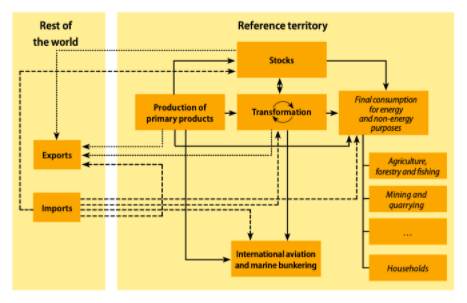
IRES uses a framework of production and consumption flows in the energy sector of a territory (a state or region). The energy product within a given territory will then be distributed as consumption goods. Energy products are also transferred in or out of a territory in the form of export and import transactions through transportation lines. In general, production flows are comprised of primary energy production (extraction of energy sources from nature), energy transformation (processing of energy resources into energy products), and final consumption (using an energy product, be it an energy product such as fuel/electricity, or a non-energy product such as lubricant).[9]Ibid
Similar to the IRES framework, in the context of Indonesia, the Ministry of Energy and Mineral Resources has developed an energy balance table, which is a balance sheet that records the system of input and output flows of energy in Indonesia, that also comprises energy production and consumption, as well as the export and import of energy resources and final energy products[10]Kementerian Energi dan Sumber Daya Mineral (ESDM). Loc.Cit, page 109-116..
Diagram of Energy Flows:
Energy Balance Table, Indonesia’s Ministry of Energy and Mineral Resources (2018)
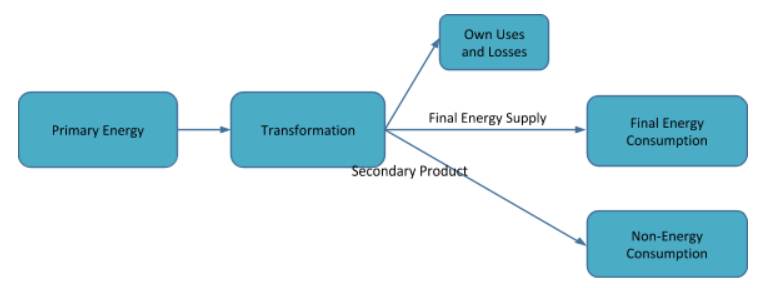
Identifying business activities in Indonesia’s energy sector is difficult using the current data system, The Central Bureau of Statistics (BPS) records economic activities, and BKPM records direct investment activities. However, both BPS and BKPM data system are missing a specific sector on energy investment. In addition, investment data published by BKPM does not depict the entirety of investment activities in Indonesia, because it does not encompass several investment sectors, such as Oil and Natural Gas. [11]Badan Koordinasi Penanaman Modal (BKPM). 2020. “National Single Window for Investment (NSWI)”. Database Website Obtained from: https://nswi.bkpm.go.id/integrator/dataumum/index.php?lang=ID … Continue reading
The Ministry of Energy and Mineral Resources’ energy balance table, as well as IRES’ Diagram of Energy Flows, can both be useful references for classifying activities that are part of business categories within the energy sector. Based on a review of the literature there is still no single and all-encompassing definition of the energy sector within Indonesia’s data collection system for energy sector investments. This makes it difficult to monitor and analyse data on energy investments in Indonesia for research purposes. Consequently, we propose using the following definition as the basis for assessing investment in Indonesia’s energy sector. This definition is based on existing energy sector definitions in: (a) Law No. 3/2007 on Energy, (b) Law No. 22/2001 on Oil and Gas, (c) Law No. 3/2020 on Mineral and Coal, and in (d) Law No. 30 of 2009 on Electricity, and also with reference to the definition in Law No. 25/2007 on Investment:
“Investment activities, both by domestic and foreign investors, in all business activities of energy provision, comprised of exploration and extraction of energy resources; transformation of energy sources into energy; energy transmission and distribution of both renewable and non-renewable energy.”
The Importance of a Comprehensive Energy Sector Database
The Investment Coordinating Board (BKPM) database does not yet have a specific energy sector category. Energy sector investment data is spread out into various sectors, such as mining and chemical industries which transforms organic matter from agriculture products into energy and fuel feedstocks, as well as provision of electricity, gas, steam, and cold air. Tracing investments in the energy sector requires analysing the different sub-sectors, as in the following graph on the realization of foreign direct investment from China from 2005–July 2020 in the Electricity, Gas, and Steam/Cold air Provision Sector.
FDI Realization from China 2005–July 2020
Provision Sector of Electricity, Gas, Steam and Cold Air
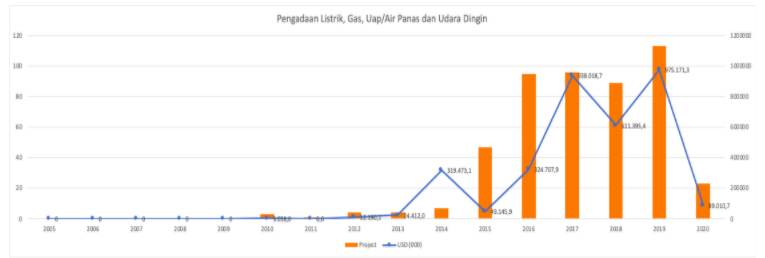
Given the importance of monitoring and analysing energy investments in Indonesia, there should be a special classification for the energy sector. The Global Development Policy Center (GDPC) at Boston University has developed such a classification for the China Global Energy Finance Database’.[12]Global Development Policy Center, Boston University. 2020. “China’s Global Energy Finance” obtained from https://www.bu.edu/cgef/#/all/Lender . Accessed on 6 July 2020. The GDPC database was designed to collect data on energy sector investment projects carried out by the People’s Republic of China in other countries, through funding from the China Development Bank and the China Export-Import Bank.
Classification of the Energy Sector in China Global Energy Finance Database,
GDPC Boston University
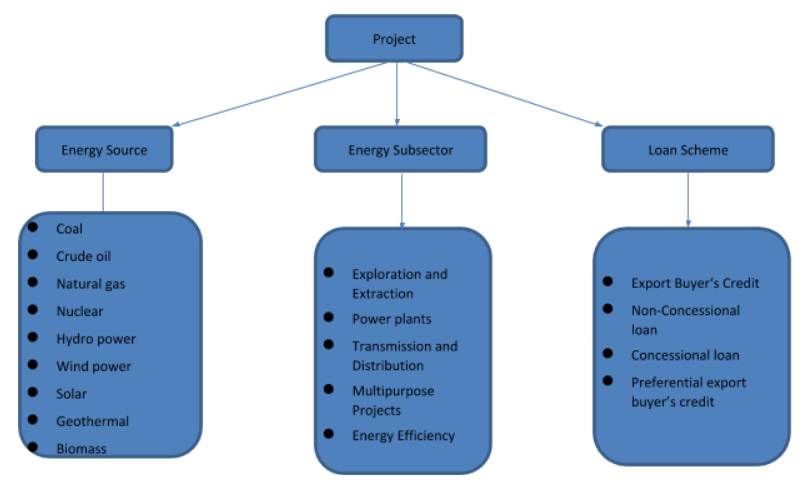
GDPC Boston University (2018) categorizes projects in the energy sector into three groups, namely energy sources (produced energy resources), energy subsector (business activities conducted), and loan schemes (loan schemes provided by banks to energy sector projects). This data classification simplifies data tracing.[13]Global Development Policy Center, Boston University. Ibid., and Global Development Policy Center, Boston University. 2018. “China’s Global Development Finance: A Guidance Note for Global … Continue reading In our assessment the GDPC Boston University database can be an excellent reference for Indonesia’s Investment Coordinating Board (BKPM) to classify investment within the energy sector.
Furthermore, we strongly recommend that the BKPM database uses the energy subsector category which classifies business activities in the energy sector. GDPC Boston University divides the energy subsector into five categories, namely exploration and extraction, power plants, energy transmission and distribusion, multipurpose projects, and energy efficiency projects.
Examples of energy efficiency projects within GDPC Boston University’s database include energy saving and the natural gas to coal conversion projects. Theoretically, energy efficiency is an attempt to use energy in a smaller amount in order to produce a larger economic output.[14]Lovins 1976, quoted in Yang, Ming & Xin Yu. 2015. Energy Efficiency: Benefits for Environment and Society London: Springer-Verlag London. Page 1. Yang and Yu (2015) define energy efficiency as ’any practice or efforts that are related to saving or conserving energy’.[15]Ibid
In order to mitigate “the absence of a stringent definition on energy sector investment,” we compared GDPC definitions and categories with energy related activities included in the Indonesia Standard Industrial Classification (ISIC) Revision 4, KBLI (2017), and BKPM’s National Single Window for Investment (NSWI). Consequently, we propose a definition of energy sector activities that is divided into five activities. First, the exploration of energy resources, as business activities in order to acquire information on the location, form, dimension, distribution, and quantified quality of energy resources, as well as information on social and environmental surroundings. Second, the extraction of energy resources, also known as exploitation, as business activities encompassing mining, processing and/or smelting of raw energy resource materials in a mining location and its auxiliary businesses.
Third, transformation, as a process of transforming energy resources (primary and alternative energy resources) into a final form of energy. In the Ministry of Energy and Mineral Resources’s energy balance sheet, transformation activities encompass: oil refining, natural gas processing, power plants, biofuel blending, and the process of natural gas regasification. Fourth, energy transmission, as the distribution of energy from transformation businesses (energy processing) and power plants into an energy distribution system. Fifth and last, the business activity of energy distribution, distributing energy to end consumers.
Based on the above sub-sectors used to group energy sector investment in Indonesia, we propose the following classification of energy sector business activities. Traction Energy Asia’s proposed classification differs slightly from GDPC’s database as it is also based on the Investment Coordinating Board classification for the Indonesian context:
Proposed Classification of Energy Sector Business Activities
| No. | Energy Subsector Categories
GDPC Boston University |
Business Activity Categories KBLI 2017 | KBLI Number Code | Business Activity Categories ISIC Rev 4 | ISIC Number Code | Investment Coordinating Board Sectors | Investment Coordinating Board Subsectors (KBLI 2015) | Investment Coordinating Board Subsector Number Code (KBLI 2015) |
| 1 | Exploration and Extraction | Coal Mining | 05101 | Mining of Hard Coal | 0510 | Mining | Coal and lignite mining | 05 |
| 2 | Exploration and Extraction | Coal Gasification in Mining Location | 05102 | Mining of Hard Coal | 0510 | Mining | Coal and lignite mining | 05 |
| 3 | Exploration and Extraction | Lignite Mining | 05200 | Mining of lignite | 0520 | Mining | Coal and lignite mining | 05 |
| 4 | Exploration and Extraction | Crude Oil Mining | 06100 | Extraction of crude petroleum | 0610 | Mining | Crude oil, natural gas, and geothermal mining | 06 |
| 5 | Exploration and Extraction | Natural Gas Mining | 06201 | Extraction of natural gas | 0620 | Mining | Crude oil, natural gas, and geothermal mining | 06 |
| 6 | Exploration and Extraction | Geothermal Enterprises | 06202 | Electric power generation, transmission and distribution | 3510 | Mining | Crude oil, natural gas, and geothermal mining | 06 |
| 7 | Exploration and Extraction | Mining of Uranium and Thorium Ores | 07210 | Mining of uranium and thorium ores | 0721 | Mining | Mining of metal ores | 07 |
| 8 | Exploration and Extraction | Mining of Lead Ores | 07291 | Mining of other non-ferrous metal ores | 0729 | Mining | Mining of metal ores | 07 |
| 9 | Exploration and Extraction | Mining of Lead Oxide Ores | 07292 | Mining of other non-ferrous metal ores | 0729 | Mining | Mining of metal ores | 07 |
| 10 | Exploration and Extraction | Mining of Bauxite/Aluminium Ores | 07293 | Mining of other non-ferrous metal ores | 0729 | Mining | Mining of metal ores | 07 |
| 11 | Exploration and Extraction | Mining of Copper Ores | 07294 | Mining of other non-ferrous metal ores | 0729 | Mining | Mining of metal ores | 07 |
| 12 | Exploration and Extraction | Mining of Nickel Ores | 07295 | Mining of other non-ferrous metal ores | 0729 | Mining | Mining of metal ores | 07 |
| 13 | Exploration and Extraction | Mining of Manganese Ores | 07296 | Mining of other non-ferrous metal ores | 0729 | Mining | Mining of metal ores | 07 |
| 14 | Exploration and Extraction | Auxiliary Activities in Crude Oil and Natural Gas Mining | 09100 | Support activities for petroleum and natural gas extraction | 0910 | Mining | Auxiliary mining services | 09 |
| 15 | Exploration and Extraction | Auxiliary Activities in Mining and Other Extraction | 09900 | Support activities for other mining and quarrying | 0900 | Mining | Auxiliary mining services | 09 |
| 16 | Multipurpose projects | Industry of Coal-based Products | 19100 | Manufacture of coke oven products | 1910 | Chemical and Pharmaceutical Industries | Industry of products derived from coal and crude oil refinin | 19 |
| 17 | Multipurpose projects | Industry of Fuels from Crude Oil Distillation and Refining | 19211 | Manufacture of refined petroleum products | 1920 | Chemical and Pharmaceutical Industries | Industry of products derived from coal and crude oil refining | 19 |
| 18 | Multipurpose Projects | Industry of Other Products from Oil Refining[16]Peraturan Kepala BPS Nomor 19 Tahun 2017 Tentang Perubahan Peraturan Kepala BPS Nomor 95 Tahun 2015 Tentang Klasifikasi Baku Lapangan Usaha Indonesia. Including manufacturing of biofuel blending such … Continue reading | 19291 | Manufacture of refined petroleum products | 1920 | Chemical and Pharmaceutical Industries | Industry of products derived from coal and crude oil refining | 19 |
| 19 | Multipurpose projects | Industry of Coal Briquettes | 19292 | Manufacture of refined petroleum products | 1920 | Chemical and Pharmaceutical Industries | Industry of products derived from coal and crude oil refining | 19 |
| 20 | Multipurpose projects | Industry of Organic Basic Chemicals from Agricultural Crops[17]Including the manufacturing of biofuel, wooden charcoal and coconut shell charcoal. For further reading see, Peraturan Kepala BPS Nomor 95 Tahun 2015 Tentang Klasifikasi Baku Lapangan Usaha … Continue reading | 20115 | Manufacture of basic chemicals | 2011 | Chemical and Pharmaceutical Industries | Industry of chemical material and chemically-derived goods | 20 |
| 21 | Multipurpose projects* | Industry of Uranium and Uranium Ore Processing | 24206 | Manufacture of basic chemicals | 2011 | Industry of Basic Metals, Metal Goods, Non-Machinery Products and Tools | Industry of basic metals | 24 |
| 22 | Multipurpose projects | Industry of Batteries | 27201 | Manufacture of batteries and accumulators | 2720 | Industry of Basic Metals, Metal Goods, Non-Machinery Products and Tools | Industry of electrical appliances | 27 |
| 23 | Multipurpose projects | Industry of Electrical Accumulators | 27202 | Manufacture of batteries and accumulators | 2720 | Industry of Basic Metals, Metal Goods, Non-Machinery Products and Tools | Industry of electrical appliances | 27 |
| 24 | Power Plants | Electric Power Generation | 35101 | Electric power generation, transmission and distribution | 3510 | Electricity, Gas, and Water | Provision of electricity, gas, steam/hot air and cold air | 35 |
| 25 | Transmission and Distribution | Electric Power Transmission | 35102 | Electric power generation, transmission and distribution | 3510 | Electricity, Gas, and Water | Provision of electricity, gas, steam/hot air and cold air | 35 |
| 26 | Transmission and Distribution | Electric Power Distribution | 35103 | Electric power generation, transmission and distribution | 3510 | Electricity, Gas, and Water | Provision of electricity, gas, steam/hot air and cold air | 35 |
| 27 | Transmission and Distribution | Auxiliary Acitivities for Electric Power | 35104 | Electric power generation, transmission and distribution | 3510 | Electricity, Gas, and Water | Provision of electricity, gas, steam/hot air and cold air | 35 |
| 28 | Multipurpose projects | Provision of Natural and Artificial Gas | 35201 | Manufacture of gas; distribution of gaseous fuels through mains | 3520 | Electricity, Gas, and Water | Provision of electricity, gas, steam/hot air and co cold air | 35 |
| 29 | Transmission and Distribution | Distribution of Natural and Artificial Gas | 35202 | Manufacture of gas; distribution of gaseous fuels through mains | 3520 | Electricity, Gas, and Water | Provision of electricity, gas, steam/hot air and cold air | 35 |
| 30 | Multipurpose projects | Provision of Biogas | 35203 | Treatment and disposal of non-hazardous waste | 3821 | Electricity, Gas, and Water | Provision of electricity, gas, steam/hot air and cold air | 35 |
| 31 | Transmission and Distribution** | Transport via Pipelines | 49300 | Transport via pipeline | 4930 | Warehouse Transport and Telecommunications | Land transport and transport via pipelines | 49 |
Source: Traction Energy Asia based on GDPC Boston University; KBLI 2015; KBLI 2017; NSWI BKPM 2020.
* It is proposed to be removed from the table because it is mixed with non-energy use. Nuclear power plants are included in the KBLI category number 35101 “Electricity Generation”.
** It is proposed to be removed from the table because the BKPM data is mixed with pipeline transportation for other materials that are not included in energy commodities.
Conclusion
The main objective of this article is to establish a definition of energy sector investment, and within that, a classification of sub-sectors for Traction’s reference in order to identify investment projects within the Indonesian Investment Coordinating Board’s database. It is hoped that our subsequent monitoring and analysis of energy investment projects, using the definition and classification outlined in this article, can enhance the applicability of other similar existing databases, such as the Global Development Policy Center’s (GDPC), China Global Energy Finance Database, in the Indonesian context.
It is crucial that investments in Indonesia’s energy sector are tracked as accurately and comprehensively as possible, given the huge potential economic, environmental, political, social and health impacts that they could have. Improving the way that energy investment data is collected and analysed will in turn
Footnotes
| ↑1 | Sartika Nur Shalahati & Jasman Simanjuntak. 2019. China Investment in The Coal Power Plant Sector in Indonesia: Finance and Portrait of Social, Environmental and Labor Impact. Report. Jakarta: AEER. Obtained from https://drive.google.com/file/d/1GRqoI3Ri6Y7qBE4pSt0CBTd2X3uEr9T7/view Accessed on 1 July 2020. |
|---|---|
| ↑2 | Auriga. 2019. “Bank dan Investor Bakar Uang di Energi Kotor”. Report. Jakarta: Auriga. Obtained from https://auriga.or.id/resources/reports/58/bank-dan-investor-bakar-uang-di-energi-kotor?lang=id Accessed on 1 July 2020. |
| ↑3 | Walhi. “Tinjauan Lingkungan Hidup 2020: Menabur Investasi Mennabur Krisis Multidimensi”. Report. Jakarta: Walhi. Obtained from https://www.walhi.or.id/wp-content/uploads/Laporan%20Tahunan/Outlook%202020.pdf Accessed on 3 July 2020. |
| ↑4 | We use the International Energy Agency (IEA) classification for renewable and non-renewable energy rather than Indonesia’s Energy Law No.30/2007 as this includes a vague classification of “new energy” – energy products produced with “new technology” (nuclear, hydrogen, coal bed methane, liquefied coal and gasified coal). IEA defines ‘renewable energy’ as “energy derived from natural processes that are replenished constantly. In its various forms, it derives directly from the sun, or from heat generated deep within the earth. Included in the definition is electricity and heat generated from solar, wind, ocean, hydropower, biomass, geothermal resources, and biofuels and hydrogen derived from renewable resources.” IEA exclude fossil energy (Coal, Oil and Gas) and nuclear from renewable and classifies them as non-renewable energy. For further reading on renewable energy see IEA Renewable Working Party. 2002. “Renewable Energy into the Mainstream”. Report. International Energy Agency. Page 9 and 14-15 |
| ↑5 | See Kementerian Energi dan Sumber Daya Mineral. 2018. “Handbook of Energy and Economic Statistics of Indonesia”. Report. Jakarta: Kementerian Energi dan Sumber Daya Mineral (ESDM). Page 16-17. |
| ↑6 | Vaclav Smill. 2017. Energy and Civilization: A History. London: The MIT Press. Page 1. |
| ↑7 | Wendell H. Wiser. 2000. Energy Resources Occurrence, Production, Conversion, Use. New York: Springer. Page 9. |
| ↑8 | United Nations Statistics Division (UNSD). 2018. “International Recommendation for Energy Statistics (IRES)”. Statistical Papers. Series M No.93. New York: United Nations. Page 56-58. |
| ↑9, ↑15 | Ibid |
| ↑10 | Kementerian Energi dan Sumber Daya Mineral (ESDM). Loc.Cit, page 109-116. |
| ↑11 | Badan Koordinasi Penanaman Modal (BKPM). 2020. “National Single Window for Investment (NSWI)”. Database Website Obtained from: https://nswi.bkpm.go.id/integrator/dataumum/index.php?lang=ID accessed on 16 July 2020. |
| ↑12 | Global Development Policy Center, Boston University. 2020. “China’s Global Energy Finance” obtained from https://www.bu.edu/cgef/#/all/Lender . Accessed on 6 July 2020. |
| ↑13 | Global Development Policy Center, Boston University. Ibid., and Global Development Policy Center, Boston University. 2018. “China’s Global Development Finance: A Guidance Note for Global Development Policy Center Databases”. Database Coding Manual. Boston: Boston University. Obtained from https://www.bu.edu/gdp/files/2018/08/Coding-Manual-.pdf . Accessed on 6 July 2020. |
| ↑14 | Lovins 1976, quoted in Yang, Ming & Xin Yu. 2015. Energy Efficiency: Benefits for Environment and Society London: Springer-Verlag London. Page 1. |
| ↑16 | Peraturan Kepala BPS Nomor 19 Tahun 2017 Tentang Perubahan Peraturan Kepala BPS Nomor 95 Tahun 2015 Tentang Klasifikasi Baku Lapangan Usaha Indonesia. Including manufacturing of biofuel blending such as the mixture of alcohol and gas. For further reading see, Peraturan Kepala BPS Nomor 95 Tahun 2015 Tentang Klasifikasi Baku Lapangan Usaha Indonesia |
| ↑17 | Including the manufacturing of biofuel, wooden charcoal and coconut shell charcoal. For further reading see, Peraturan Kepala BPS Nomor 95 Tahun 2015 Tentang Klasifikasi Baku Lapangan Usaha Indonesia.
Peraturan Kepala BPS Nomor 19 Tahun 2017 Tentang Perubahan Peraturan Kepala BPS Nomor 95 Tahun 2015 Tentang Klasifikasi Baku Lapangan Usaha Indonesia. |

